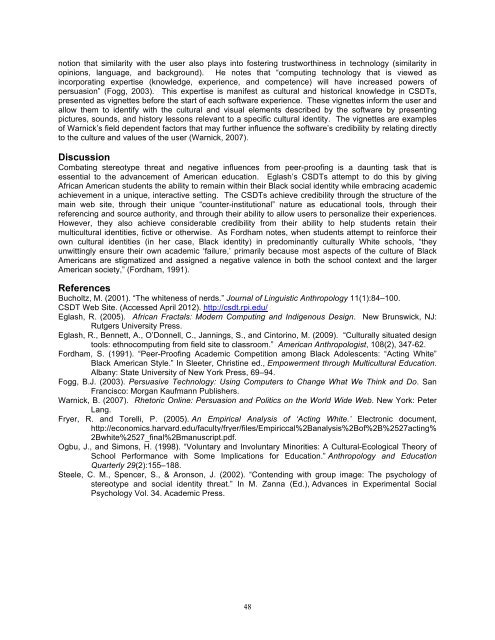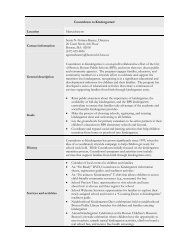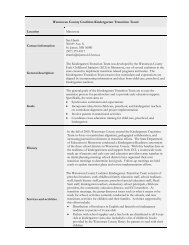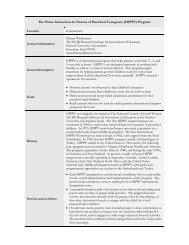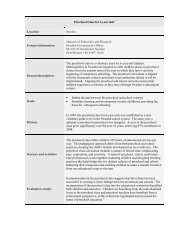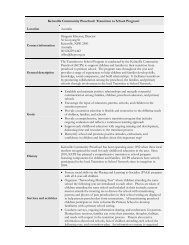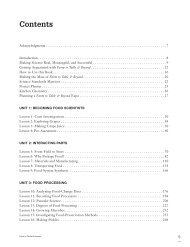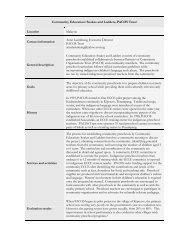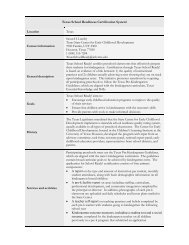Proceedings of the Fourth Annual Teachers College Educational ...
Proceedings of the Fourth Annual Teachers College Educational ...
Proceedings of the Fourth Annual Teachers College Educational ...
You also want an ePaper? Increase the reach of your titles
YUMPU automatically turns print PDFs into web optimized ePapers that Google loves.
notion that similarity with <strong>the</strong> user also plays into fostering trustworthiness in technology (similarity in<br />
opinions, language, and background). He notes that “computing technology that is viewed as<br />
incorporating expertise (knowledge, experience, and competence) will have increased powers <strong>of</strong><br />
persuasion” (Fogg, 2003). This expertise is manifest as cultural and historical knowledge in CSDTs,<br />
presented as vignettes before <strong>the</strong> start <strong>of</strong> each s<strong>of</strong>tware experience. These vignettes inform <strong>the</strong> user and<br />
allow <strong>the</strong>m to identify with <strong>the</strong> cultural and visual elements described by <strong>the</strong> s<strong>of</strong>tware by presenting<br />
pictures, sounds, and history lessons relevant to a specific cultural identity. The vignettes are examples<br />
<strong>of</strong> Warnick’s field dependent factors that may fur<strong>the</strong>r influence <strong>the</strong> s<strong>of</strong>tware’s credibility by relating directly<br />
to <strong>the</strong> culture and values <strong>of</strong> <strong>the</strong> user (Warnick, 2007).<br />
Discussion<br />
Combating stereotype threat and negative influences from peer-pro<strong>of</strong>ing is a daunting task that is<br />
essential to <strong>the</strong> advancement <strong>of</strong> American education. Eglash’s CSDTs attempt to do this by giving<br />
African American students <strong>the</strong> ability to remain within <strong>the</strong>ir Black social identity while embracing academic<br />
achievement in a unique, interactive setting. The CSDTs achieve credibility through <strong>the</strong> structure <strong>of</strong> <strong>the</strong><br />
main web site, through <strong>the</strong>ir unique “counter-institutional” nature as educational tools, through <strong>the</strong>ir<br />
referencing and source authority, and through <strong>the</strong>ir ability to allow users to personalize <strong>the</strong>ir experiences.<br />
However, <strong>the</strong>y also achieve considerable credibility from <strong>the</strong>ir ability to help students retain <strong>the</strong>ir<br />
multicultural identities, fictive or o<strong>the</strong>rwise. As Fordham notes, when students attempt to reinforce <strong>the</strong>ir<br />
own cultural identities (in her case, Black identity) in predominantly culturally White schools, “<strong>the</strong>y<br />
unwittingly ensure <strong>the</strong>ir own academic ‘failure,’ primarily because most aspects <strong>of</strong> <strong>the</strong> culture <strong>of</strong> Black<br />
Americans are stigmatized and assigned a negative valence in both <strong>the</strong> school context and <strong>the</strong> larger<br />
American society,” (Fordham, 1991).<br />
References<br />
Bucholtz, M. (2001). “The whiteness <strong>of</strong> nerds.” Journal <strong>of</strong> Linguistic Anthropology 11(1):84–100.<br />
CSDT Web Site. (Accessed April 2012). http://csdt.rpi.edu/<br />
Eglash, R. (2005). African Fractals: Modern Computing and Indigenous Design. New Brunswick, NJ:<br />
Rutgers University Press.<br />
Eglash, R., Bennett, A., O’Donnell, C., Jannings, S., and Cintorino, M. (2009). “Culturally situated design<br />
tools: ethnocomputing from field site to classroom.” American Anthropologist, 108(2), 347-62.<br />
Fordham, S. (1991). “Peer-Pro<strong>of</strong>ing Academic Competition among Black Adolescents: “Acting White”<br />
Black American Style.” In Sleeter, Christine ed., Empowerment through Multicultural Education.<br />
Albany: State University <strong>of</strong> New York Press, 69–94.<br />
Fogg, B.J. (2003). Persuasive Technology: Using Computers to Change What We Think and Do. San<br />
Francisco: Morgan Kaufmann Publishers.<br />
Warnick, B. (2007). Rhetoric Online: Persuasion and Politics on <strong>the</strong> World Wide Web. New York: Peter<br />
Lang.<br />
Fryer, R. and Torelli, P. (2005). An Empirical Analysis <strong>of</strong> ‘Acting White.’ Electronic document,<br />
http://economics.harvard.edu/faculty/fryer/files/Empiriccal%2Banalysis%2B<strong>of</strong>%2B%2527acting%<br />
2Bwhite%2527_final%2Bmanuscript.pdf.<br />
Ogbu, J., and Simons, H. (1998). “Voluntary and Involuntary Minorities: A Cultural-Ecological Theory <strong>of</strong><br />
School Performance with Some Implications for Education.” Anthropology and Education<br />
Quarterly 29(2):155–188.<br />
Steele, C. M., Spencer, S., & Aronson, J. (2002). “Contending with group image: The psychology <strong>of</strong><br />
stereotype and social identity threat.” In M. Zanna (Ed.), Advances in Experimental Social<br />
Psychology Vol. 34. Academic Press.<br />
48


